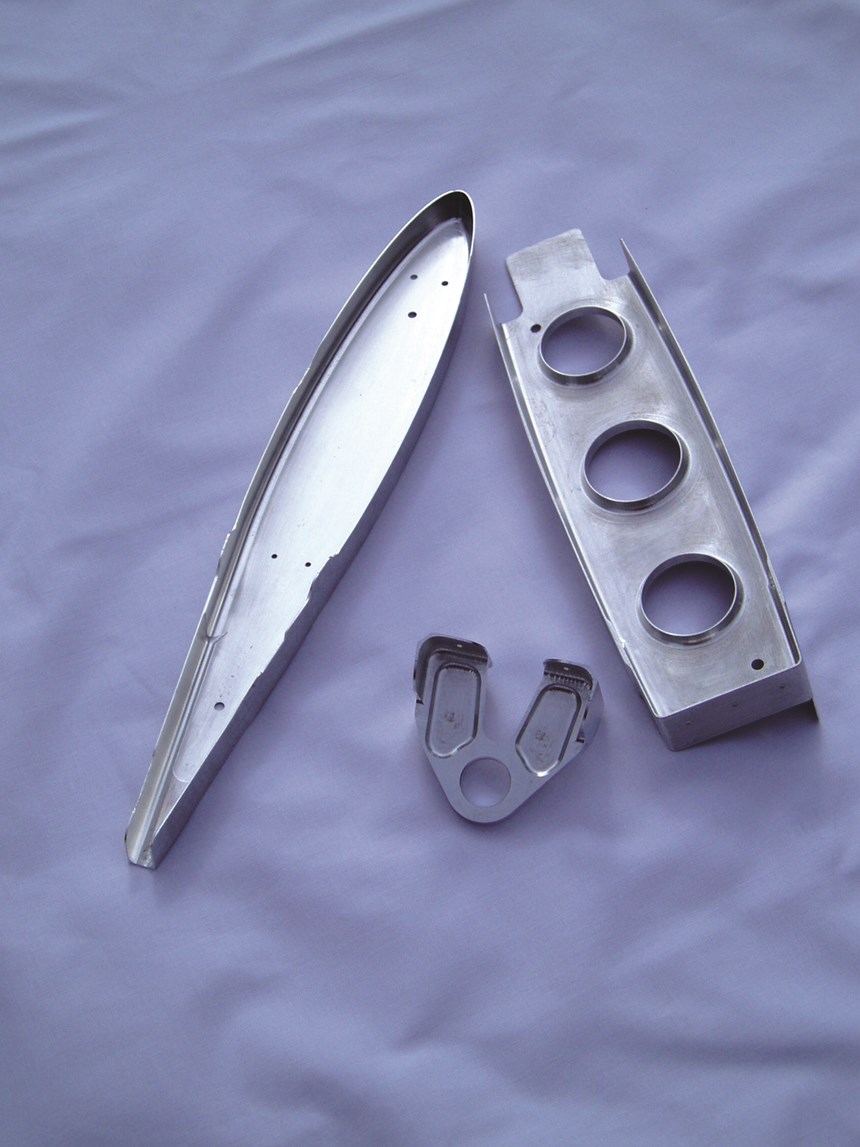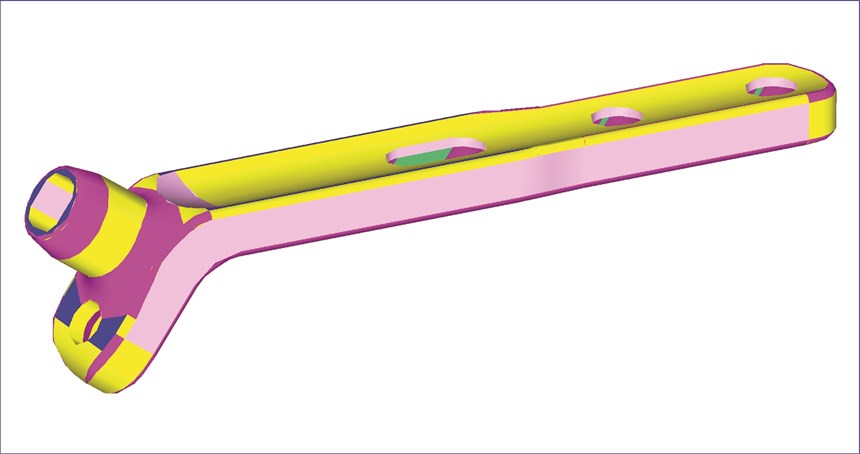CAM System Adapts To Changing Needs
Fast, accurate programming can save time and money for any manufacturer. For a provider of contract programming services, however, choosing the right CAM software is even more important. Available from Numerical Control Computer Sciences (NCCS), the NCL CAM package enables one programming company in the United Kingdom to handle work ranging from everyday machining to complex, five-axis jobs.
Share






.png;maxWidth=45)
DMG MORI - Cincinnati
Featured Content
View More
With the increasing pressure of global competition, fast and accurate programming can help today’s job shops manufacture high-quality parts in the shortest possible amount of time. Recognizing the importance of quality software, Peak NC Limited, a provider of NC programming services in the United Kingdom, sought to find a CAM system that was easy to learn and adapt to smaller jobs, yet powerful enough to handle even the most complicated projects. With the flexibility and tool-control capability of NCL CAM software from Numerical Control Computer Sciences (NCCS), the company has been able to provide quick and efficient service to customers while keeping costs low.
With more than 30 years of programming experience, Peak NC serves clients in industries including aerospace, oil exploration, hydraulics, medical and more. Customers range from small, highly specialized precision engineering firms to household names in international aerospace production such as Airbus and Rolls Royce. The company specializes in the programming of five-axis components and high speed machining for jobs ranging from everyday manufacturing needs to extreme projects. Its work spans an extensive range of component types and materials as well as on-site support services.
Subcontract programming is a demanding environment for any CAM system because of the sheer variety of work undertaken, and Peak NC is no exception. Director Lucy Butler says the company chose the NCL CAM package from NCCS because the software can handle many types of components made from many different materials on many different machine tools. The company continually upgrades its software to maintain a competitive edge, and it currently uses NCL version 9.6 to program the most difficult structural components.
The software generates simultaneous two- through five-axis NC tool paths and provides parametric 3D modeling. All geometric modeling and toolpath functions are fully associative—that is, a change to the model results in an immediate change to corresponding tool paths. According to NCCS, this makes the software well-suited for environments such as the aerospace industry in which design changes are frequent. The software also supports fully parametric programming, through which a family of parts can be machined by simply filling in a form.
"NCL’s greatest strength is its flexibility—the ability to generate highly efficient tool paths for even the most complex components through a mixture of automation and precise tool control," Ms. Butler says. She adds that another valuable feature is the software’s automated routines, particularly for roughing. "For example, we can use standard machining routines to handle common operations for regularly recurring complex features, or we can employ unique machining strategies that we define ourselves using macros, loops and data structures," Ms. Butler explains. These capabilities reduce programming time, thereby increasing the company’s overall productivity and profits.
Recent jobs Peak NC has programmed using NCL’s five-axis package include airframe assemblies, titanium aero engine parts and nuclear components made from high-grade steels. The company says these complex aero engine and nuclear component projects benefited from the software’s precise control over tool-axis vectors, which enabled machining of finished components to very tight tolerances.
In addition to NCL, the company uses NCCS’ verification software and postprocessor module. NCL/IPV is an integrated numerical control simulation and verification module designed to provide a fast, accurate way to simulate the material removal process of NC tool paths. The user can instantly verify tool paths at any time during an NCL CAM session, even while those tool paths are being created. During and after the metal removal process, the cut model can be viewed from any orientation, cross-sectioned, inspected and compared with an existing solid model. The verification module can also verify existing tool paths from NCL or other CAM systems. According to the company, NCL/IPV reduces the need for costly tape prove-outs and ensures accurate, efficient and safe NC programs.
PostWorks is a universal two- through 10-axis postprocessor and postprocessor generator. It converts output from most major CAM systems into NC data files, which can be used to run virtually any NC device, including mills, lathes, turn-mills, CMMs, lasers and more. The postprocessor module is designed with a simple interface, which is said to allow the user to easily establish machine configurations, control unit features and output file formats. Additionally, it automatically creates a solid model of the machine and dynamically simulates machine movement. The module also provides a comprehensive macro language for easy customization, the company says.
Peak NC concludes that these benefits and NCL’s wide range of capabilities enable it to easily handle its five-axis work. The fact that the software is a language-based system in which each and every motion is under the programmer’s absolute control is critical when working on difficult five-axis components, the company says. With NCL, programmers can easily adapt machining methods to suit the needs of the particular client, machine tool or component.
Related Content
Can ChatGPT Create Usable G-Code Programs?
Since its debut in late 2022, ChatGPT has been used in many situations, from writing stories to writing code, including G-code. But is it useful to shops? We asked a CAM expert for his thoughts.
Read MoreCutting Part Programming Times Through AI
CAM Assist cuts repetition from part programming — early users say it cuts tribal knowledge and could be a useful tool for training new programmers.
Read MoreContinuous Improvement and New Functionality Are the Name of the Game
Mastercam 2025 incorporates big advancements and small — all based on customer feedback and the company’s commitment to keeping its signature product best in class.
Read More5 Tips for Running a Profitable Aerospace Shop
Aerospace machining is a demanding and competitive sector of manufacturing, but this shop demonstrates five ways to find aerospace success.
Read MoreRead Next
Building Out a Foundation for Student Machinists
Autodesk and Haas have teamed up to produce an introductory course for students that covers the basics of CAD, CAM and CNC while providing them with a portfolio part.
Read MoreRegistration Now Open for the Precision Machining Technology Show (PMTS) 2025
The precision machining industry’s premier event returns to Cleveland, OH, April 1-3.
Read MoreSetting Up the Building Blocks for a Digital Factory
Woodward Inc. spent over a year developing an API to connect machines to its digital factory. Caron Engineering’s MiConnect has cut most of this process while also granting the shop greater access to machine information.
Read More

















.png;maxWidth=150)



















.jpg;maxWidth=300;quality=90)














